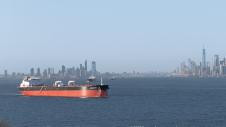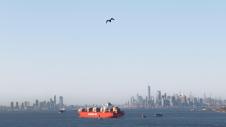Just a couple of months ago at Posidonia, the euphoria of the strong shipping markets was permeating the party scene at the corporate events in the Athens Riviera. The markets were just great!
Two months later, the market mood is more concerning. Shipping markets have always been known for their volatility, and the recent market softening may be partially attributable to “market noise”, no doubt; what goes up, it comes down, too, at some point, and the cycle starts anew. Besides “market noise”, there may be certain correlation with other markets in play too. After all, the public equity markets, like the Dow Jones and the S&P, have been gyrating on their own for the whole summer. Thus, it’s not just the shipping markets that seem to be rudderless of late.
And, as unpleasant as the recent softening with the shipping markets has been, still, times are not bad. The tanker markets have had an acceptable time, the dry-bulk markets have had a very profitable run last year, and containership owners just have been printing money for almost two years now. Unlike the weak markets in 2013 and 2016, when shipowners were in a bad financial situation to begin with and could ill-afford bad markets, presently, shipowners are overall in a very decent, to say the least, financial shape. They are enjoying accumulated earnings, shipping finance has been getting ever more active once again, and the values of marine assets are strong.
So, why worry then?
The big difference from previous (normalized) markets is that the strong shipping freight rates in the last year or so have not been due to structural demand (on what consumers and companies buy based on their needs and desires), but rather on shifting trading patterns that have caused global supply chain disruptions, which artificially pushed freight rates higher. The strong freight market has been supply-driven rather the more conventional demand-driven market. The subtle difference based on the earnings driver is not necessarily sinister, as, after all, a strong market brings profits irrespective of the cause. However, one now may start wondering whether such a difference has more importance than plain semantic value these days.
The shipping picture fits in a broader macro-economic landscape, as, at least in the USA, currently high inflation is deemed supply - rather demand - driven, and thus the lengthy editorials that the Fed has mis-diagnosed the cause of the inflation, and it has been too slow to respond with a prompter higher interest rate increases. And, as now the Fed steps on the pedal to make up for the lost ground, interest rates are moving higher than expected and stock markets are coming into grips with the new “neutral” landscape. For the publicly traded shipowners, the summer has not been exceptionally good, as shipping equity prices generally have moved lower in a broadly weakening market.
As the Fed keeps a bias towards higher interest rates, the U.S. Dollar has been on a tear against all major currencies, with the Japanese Yen at a forty-year low, the Euro at parity and a good chance that parity may seem the destiny for the British Pound as well. Currency exchange rates where the Dollar stands high have a global inflationary impact (among other things, all commodities are priced in U.S. Dollar), and there are fears for a global recession, if not social unrest in certain countries that could not afford to import food and grains priced on U.S. Dollar terms. And, a global recession, is not good for shipping, we all know. The Baltic Dry Index (BDI) temporarily dipped below 1,000 last week, having started the year at 2,285 points, with many commentators surmising that the direction of such a leading indicator does not bode well for the world market, and shipping.
Taking a step back, the supply-driven strength of the containership market had been obvious to all, and there is nothing new to report on this. When there were more one hundred containerships at anchor outside the ports of Long Beach and Los Angeles in California due to congestion, containership freight rates were high because 15%-20% of the world’s containership fleet were artificially tied-up at anchor, rather than busy with transporting cargo in demand. And, as U.S. retailers like Walmart and Target had to write down excess inventory bought in anticipation of shipment delays but now un-demanded by the consumers, containership rates are coming down. Still, it costs more than $5,000 to ship a container from Shanghai to California today and still a very profitable rate (it used to be just $500 a few years ago), but in the last couple of years containership vessels have changed hands at stratospheric pricing levels. While a declining containership freight market is not unusual, many charters and financings and ship mortgages for containerships in the last couple of years were made for heavenly markets and can barely afford a fall from grace (or any kind of price fall); in such respect, the drop of containership rates are of concern. Supply-driven high rates may be harder to tame, but, they are not immune to rate declines.
As for the tanker market, although it has not shared the strong fortunes of the dry-bulk and containership markets in the last year or two, still tanker rates were overall profitable, and tanker asset prices strong, based on strong overall demand. As a reference, the tanker market sky-rocketed at the beginning of the pandemic, when there was too much unused crude oil that needed storage—that brief moment when oil was priced negatively (oh, those were the days!), which again was a supply-driven rate spike, but afterwards the market normalized at fair freight rates. At present, with the prospects of a global recession looming, there have been high hopes for a stronger tanker market based on Russian oil sanctions, lifting of Iranian oil sanctions, and of shifting trading patterns that will increase ton-mile; once again, the hope is based on supply-chain rates increases rather than structural demand (which actually seems to decrease, inelastically, given super-high gasoline prices, etc.)
Is this the end of a bull market in shipping? Hardly, if at all. With a world coming out of a once-in-a-lifetime pandemic, with supply chain disruptions compounded with fiscal and monetary stimulus packages globally, and with a widely unexpected war in Europe that has upended the energy markets—to put it gently, the markets were given too much to “digest”. Probably talks for a “hard landing” U.S. and/or global recession are exaggerated (at least in the U.S., companies have hard time hiring people), and the prospects for shipping are not as bad as feared. Supply-driven high rates were expected to come down, and it was a matter of time; but it does not mean that the market is in free fall; not after the profits shipowners have pocketed in the last two years or so.
*Basil M. Karatzas is the Founder of Karatzas Marine Advisors & Co and Karatzas Auctions, active in the maritime industry as financial advisors, shipbrokers and marine appraisers. Mr Karatzas is a Certified Marine Surveyor, an Accredited Senior Appraiser for marine assets, and a Fellow with the Institute of Chartered Shipbrokers in the UK.








